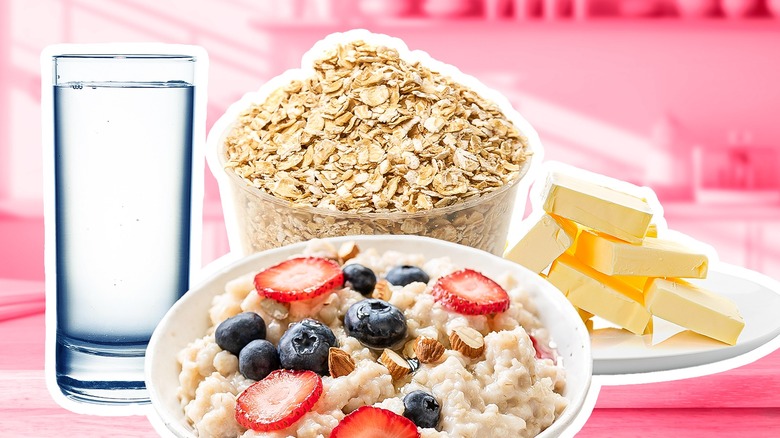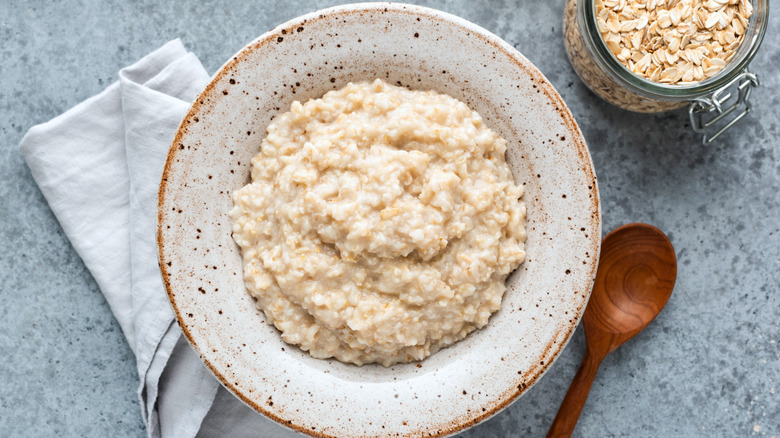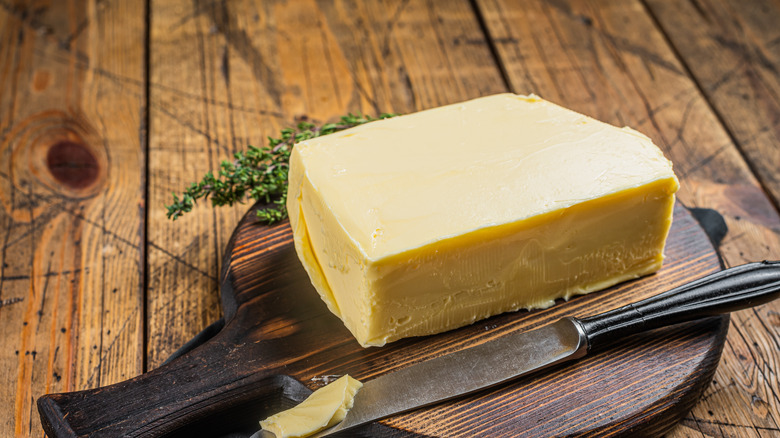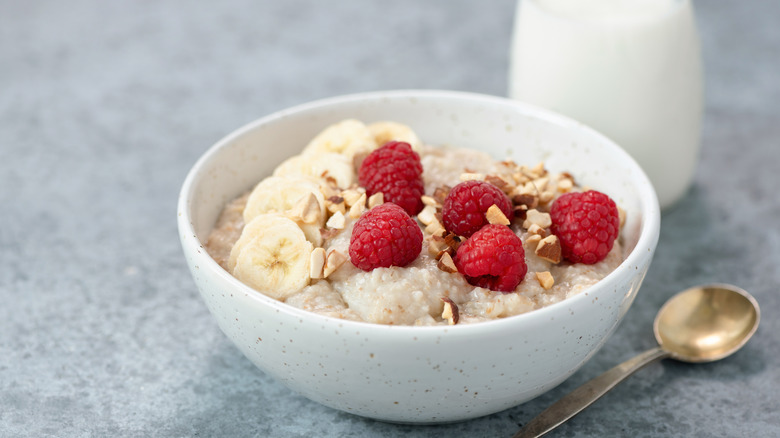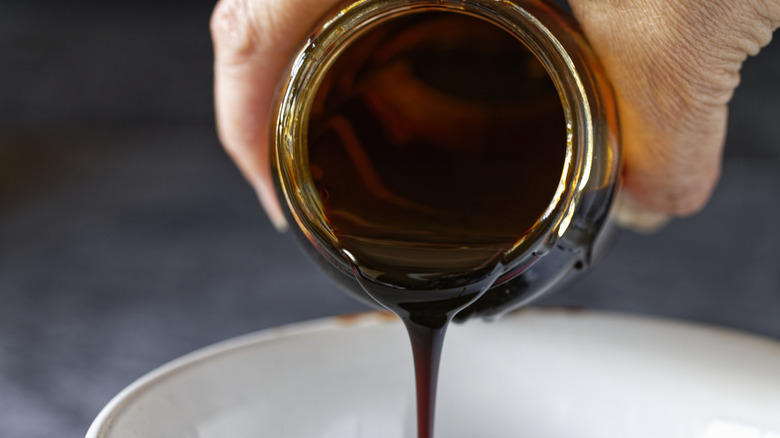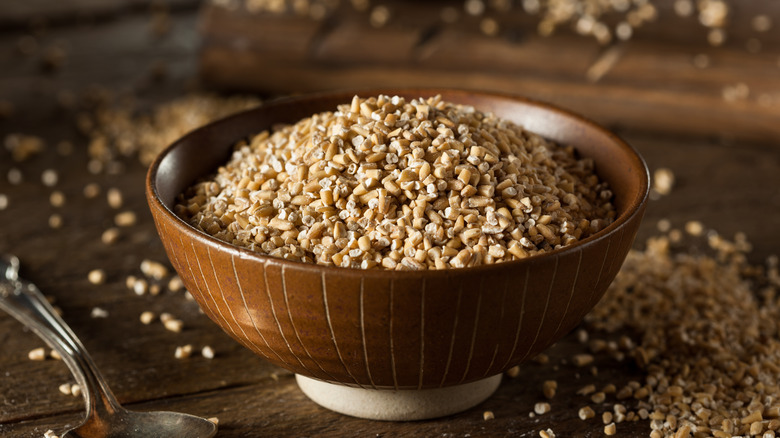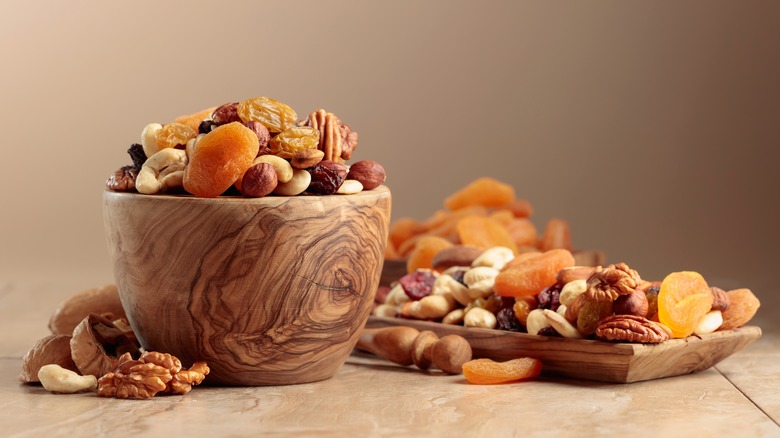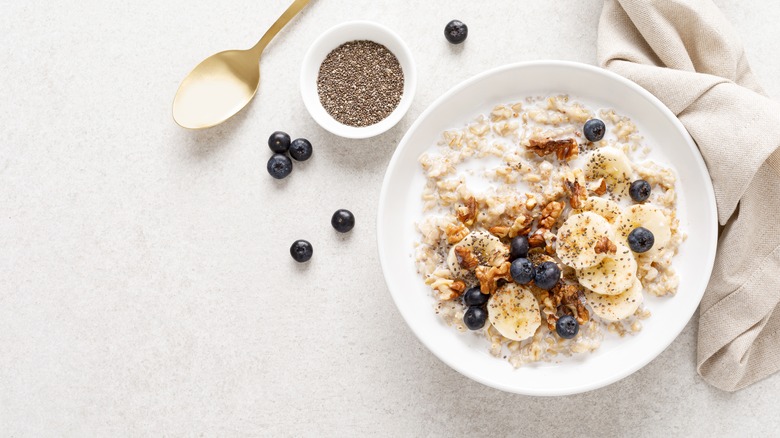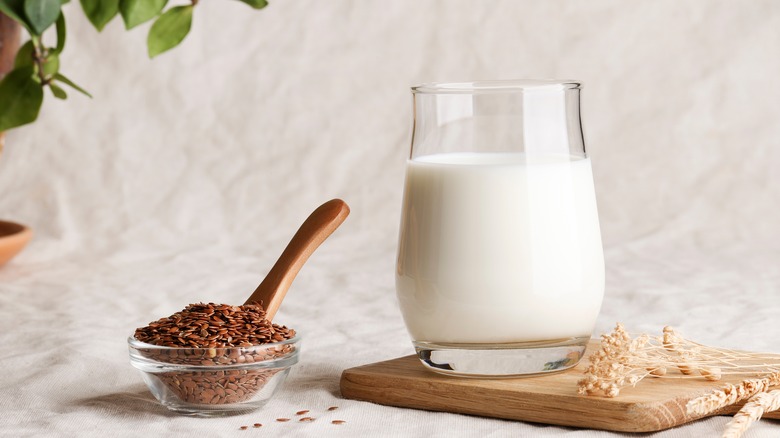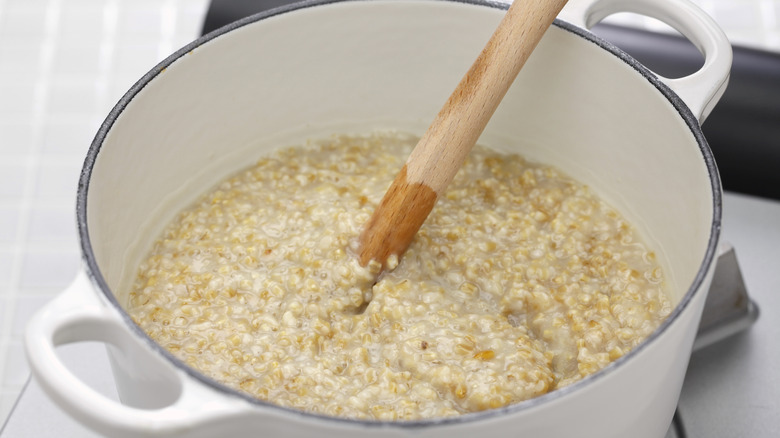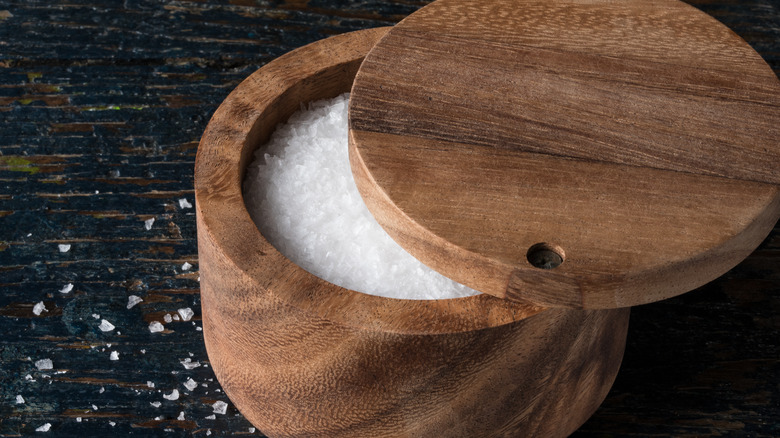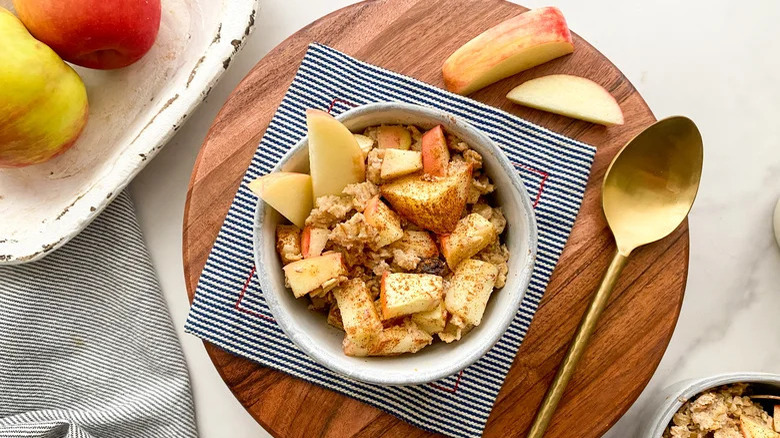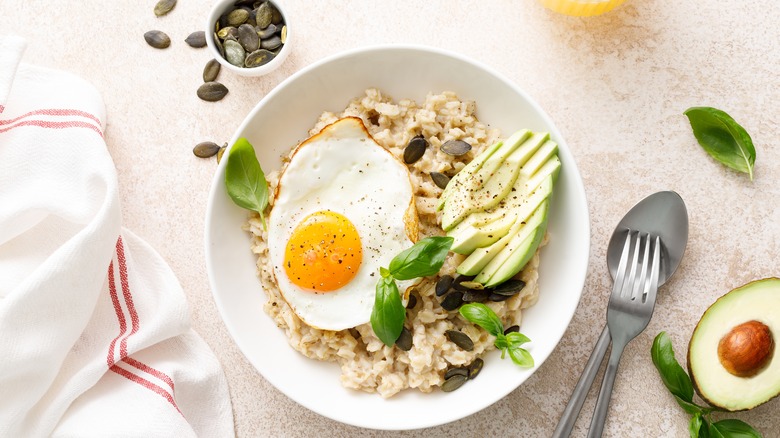12 Mistakes You Need To Avoid When Cooking Oatmeal
Oatmeal is a classic breakfast staple across America and in many other countries, too. At its most basic, oatmeal is made with oats that are either rolled, crushed, or steel-cut, cooked in water or milk, sweetened with sugar, honey, or maple syrup, and then served warm. Common additions include fresh or dried fruits such as bananas and berries, as well as nuts and seeds like almonds, walnuts, or flaxseeds, which provide a satisfying crunch.
But that's just the most common way to enjoy oatmeal. You can just as easily have it raw, especially when dealing with quick-cooking oats, which are sliced so thin they're easily digestible even without being cooked. This version resembles muesli, which is often just oats mixed with dried fruit and served with cold milk or yogurt. Incidentally, oatmeal also makes a great base for savory ingredients. Danish restaurant chain Grød bet on that concept and is doing just fine for itself serving sweet and savory oatmeal dishes, while a poached egg or a sprinkle of cheese always make for a good savory breakfast.
Miriam Hahn, a Tasting Table recipe developer and wellness coach whom we interviewed for this article, is a big fan of oatmeal and says her favorite way to make it is as a savory dish. But as easy and versatile as oatmeal is, it's not foolproof. So, let's look at some of the most common mistakes people make when preparing it, with the help of Hahn's expert insight.
1. Not using enough liquid in the oatmeal
There is a lot of debate over which type of liquid to use when cooking oatmeal. Should it be water or milk? And if milk, which type? But there is one thing that we all must agree on, and that is that there should definitely be enough liquid in the pot to cook the oatmeal without drying it out. Miriam Hahn tells Tasting Table that she finds people often make the mistake of not using enough liquid when cooking oatmeal, noting that this can happen especially when preparing a single portion.
This causes the oatmeal to stick to the pan and burn, not to mention that you'll have a pretty big task of unsticking that pot with some steel wool and elbow grease after the fact. Hahn recommends avoiding this problem by making larger batches and refrigerating them for later, or by using an instant pot. Encountering this problem when cooking oatmeal in the microwave could be even messier. Noting her lack of luck with this oatmeal cooking method, Hahn asserts that, in her experience, the stuff tends to just explode.
2. Leaving out the butter
Butter seems to have the ability to turn all kinds of mediocre dishes into something great. A so-so risotto can instantly be transformed into a restaurant-worthy dish just by adding a pat of butter to the pot right after it's removed from the heat. Chicken piccata probably wouldn't be half as popular as it is without the addition of that whole stick of butter to the recipe. Yet, for whatever reason, we often tend to leave butter out of the oatmeal equation. That stops today.
Adding a pat of butter to your cooked oats will turn the dish into a thicker, creamier, and overall better version of itself. As the butter melts, it will impart its flavor into the oats, milk, brown sugar, and any other ingredients you like to add to your breakfast bowl, while also giving the oats a more velvety texture. Fats, like butter, also tend to make us feel fuller for longer, which means you may not have to snack on anything until lunch if you add butter to your oatmeal in the morning.
3. Overcomplicating the oatmeal
One of the best things about oatmeal is that it's quick and easy to make. It's a great way to start your day because preparing it in the morning shouldn't take up too many of your decision-making capabilities, which could otherwise lead to the dreaded decision fatigue that won't allow you to easily choose between a Ceasar salad and a plate of risotto by the time you get to lunch.
In other words, the way to make a perfect bowl of oatmeal is to keep it simple. So, when it comes time to add ingredients to your oatmeal, be sure to select items that go well together in terms of flavor and texture. For instance, pick a theme by sticking only to dried fruit and nuts, in which case you can add goji berries, cranberries, and even almonds without overthinking it. Or you can go the savory route by sticking to ingredients that typically go together, like eggs and avocado.
Miriam Hahn recommends any type of fruit, but says, "I typically put blueberries, blackberries, and either strawberries or raspberries because of their high antioxidant count, and they taste delicious." Hahn adds, "Sometimes I add frozen wild blueberries to the pot while cooking to turn the oats into blueberry oats."
4. Sticking with the same sweetener every time
Maple syrup, brown sugar, and honey are all popular oatmeal sweeteners, and for good reason. They don't just sweeten the pot — they each bring a rich caramel flavor to the mix while also boosting the texture. But variety is the spice of life, so we thought we'd let you know about another, less common sweetener that you might be missing out on: molasses makes an excellent sweet addition to your morning oatmeal.
This ingredient, a byproduct of the sugar-making process, is just as sweet as the others and also provides a nice caramel flavor. But in addition to that, it also boasts a subtle bitter taste along with some smokiness, which adds more depth to the whole oatmeal experience. Molasses is also the thickest of the previously mentioned sweeteners, which means it can also thicken the texture of the oatmeal dish, if you so desire. Play around with different types of molasses, including light, dark, and blackstrap, which are all sweet but have slightly different flavor undertones.
Further enhance the effect of the molasses by adding warm spices to your oatmeal, such as cinnamon, ground ginger, or allspice. This variation works especially well in the colder months, when warm and spicy flavors do wonders for your mood.
5. Choosing the wrong oats
Oats come in many different forms, including rolled, instant, and steel-cut. This leads to different shapes, health benefits, and cooking times, as well as a variety of flavors and textures. Most crucially, it also means you need to adapt your cooking time and style to the oats you've chosen — this is not a one-size-fits-all sort of deal, particularly when it comes to that nutrition factor. In fact, Miriam Hahn tells us, "Steel-cut oats are the healthiest because they are less processed, have more fiber, and are lower on the glycemic index. However, they take longer to cook." On the other hand, she adds, "Rolled oats are excellent for you and are quicker to cook." But Hahn says that quick-cooking oats are the worst choice because they are the most processed and therefore less nutritious.
These are important distinctions to be aware of when cooking your morning oatmeal. Although Hahn notes that it's difficult to truly mess up steel-cut and rolled oats recipes, as they're generally easy to prepare, you do have to remember which ones you're working with so that you can determine how long to cook them for.
6. Adding dried fruit to the oatmeal too soon
Dried fruit is a popular addition to oat products, whether in muesli or in cooked oatmeal. They are a great way to add sweetness and tartness to the dish without overdoing the sugar component, and they can also provide a nice textural break from typically mealy oatmeal. But if you're too eager to add that fruit, you may end up ruining your breakfast. In fact, it's best not to add the dried fruit too soon, or you may end up turning it to mush that's more reminiscent of gruel than oatmeal and creating a very different meal.
This is why we recommend following Ina Garten's trick for adding dried fruit to oatmeal. She makes sure that the oatmeal is almost done cooking, and then she adds raisins, bananas, and dried cherries before placing the lid on top of the pot. This creates a little steam chamber where the fruit has just enough time to rehydrate and become plump before it turns to mush. This leaves the fruit with a juicy pop when you bite into it.
Just don't leave it covered for more than two minutes, or that mushy fate we mentioned may befall you. Garten recommends serving your bowl of oatmeal with some milk and a drizzle of maple syrup.
7. Using the wrong liquid
Water and milk are both widely used to cook oatmeal, whether in the microwave or on the stove — but that doesn't mean they are equally great options. In fact, while for some applications water works best, in others, you'll want to opt for milk. For instance, if you're planning on making overnight oats, you'll likely want to choose milk as your liquid base. This is because the milk will impart a creamier texture onto your oats, along with more depth of flavor. Conversely, while water will technically soften your oats, it could also lead to a runnier texture.
On the other hand, if you're making simple, stovetop oats, water might be the best choice. Some cooks insist that you should never cook oatmeal in milk, because this can lead to a gummy, sticky outcome. As such, they prefer to add a splash of milk after the oatmeal has been cooked in water in order to avoid this problem, while also enjoying the creaminess and added flavor milk can provide.
That said, if you're a big milk and oatmeal fan, don't be afraid to use this dairy (or plant-based) product. Just make sure you consume your meal right away before that gummy texture starts to develop.
8. Selecting the wrong type of milk for oatmeal
Once you've decided that you're definitely a milk person when it comes to cooking oats, then it's time to think about what type of milk will work best for your breakfast. Full-fat or skim cow milk will reliably give you a creamy and flavorful oatmeal, but there are also plenty of plant-based options to consider, even if you aren't vegan or need to avoid dairy more generally. Plant-based milks are delicious and nutritious in their own right these days, and it would be a shame to leave them out of the running.
Miriam Hahn, for one, tells Tasting Table, "I only drink plant-based milks, and all work great, but my favorite is Good Karma flaxmilk." She explains, "It is much creamier and, in my opinion, complements the oats the best. Plus, you get all of the omega-3s that flaxseed offers and a good source of plant-based protein."
However, Hahn adds that it's best to avoid plant-based milks with added sugar. Aside from any health concerns that may result from excessive sugar consumption, this can also interfere with the balance of flavor. If you do happen to use milk with added sugar, be sure to dial back the other sweeteners you were planning on adding.
9. Over-stirring the oats
Oatmeal is generally pretty easy to make, regardless of which oats or liquid you choose. As Miriam Hahn puts it, "Oats are very forgiving." Indeed, the oats won't easily burn or undercook — but there is a chance that the oatmeal could become chewy. And paradoxically, this outcome can happen when you're trying too hard. In fact, over-stirring the oatmeal as you cook it could lead to a gluier texture that is none too appealing. This is because, as you move the oats around, they release more starch; and the more you move them around, the more starch gets released. This is what contributes to that undesirable chewy texture in oatmeal.
The good news is that it's easier to fix this than to create the problem in the first place. Simply put your oats on the stove with your liquid of choice and leave them there until they're done. As long as you have enough milk or water in there, or you don't cook them for too long, they won't burn. If you find that your oats are all gathered in one spot, you can certainly stir them up a little, but once or twice is enough.
10. Omitting the salt
You may have noticed that almost all recipes call for salt, whether they're sweet or savory. For the savory ones, the reason is intuitive — but do you know why salt is also added to sweet dishes, albeit in smaller quantities? This is because the salt actually enhances the sense of sweetness humans perceive in foods, meaning that salt intensifies flavor in desserts, too. So, if you're planning on making sweet or savory oatmeal, be prepared to add a pinch of salt either way. Indeed, salt won't just bring out the sweetness in your oatmeal — it will also bring out the flavor in practically every other ingredient, including the oats themselves.
For best results, be sure to get the timing right. If you add salt too late, the oatmeal will just end up being salty, which is only okay if you're making a savory version. As such, don't forget to add the salt in the beginning, when you start heating up the water or milk. A similar calculation must be made with quantity. You can add more salt to the pot if you're making something savory, but for a sweet oatmeal, stick with no more than a pinch of salt.
11. Forgetting that oatmeal can be baked
Oftentimes, especially when we're in a hurry, we'll pop some oatmeal in the microwave with some milk or water, or cook it on the stovetop, or just pour it in a bowl with some cold yogurt and dried fruit. But while these are fine, if expedient, ways to make and enjoy oatmeal, they're not the only ones. Indeed, oats also lend themselves extremely well to baking, and that is something many people often forget ... to their culinary peril.
Okay, so it's not exactly perilous to eat oatmeal cooked on a stove or microwave, but it would be a real shame to miss out on this cooking method. Luckily, Miriam Hahn has come to the rescue with a great cinnamon apple baked oatmeal recipe that is almost as easy to make as the microwaved stuff, and it's much easier on the palate. Just combine all the ingredients in an oven dish, making sure you top the mixture with the chopped apples, and bake everything until the apples are soft.
Another great option is this peanut butter and roasted banana baked oatmeal, which calls for some of the oats to be blended into a flour before being added to the mixture with the roasted bananas and other ingredients. This leads to a more cakey consistency, but you're still dealing with oatmeal — which means you can get all the nutrition benefits of this food while eating something that tastes more like a dessert.
12. Eschewing the savory angle when cooking oatmeal
We've mentioned savory oatmeal in this article already, but since sweet versions of this dish are consumed so much more often — at least in this country — it's worth giving this version of the dish its own explanation. Indeed, savory ways of cooking oatmeal have been too often underrated, and that's a big mistake people make when cooking oatmeal.
Not only can oatmeal make a great base for savory toppings like fried eggs or everything bagel seasoning, but they can also be cooked in broth, which infuses all its warm flavors into the oats before you even get to the accompaniments. You can even get creative with the type of broth you use, opting for a store-bought chicken or vegetable broth, a bone broth, or a homemade version packed with umami. After the oatmeal is cooked, you can then top it with ingredients that complement the broth you used, such as grilled chicken or sauteed mushrooms.
In short, you can use oatmeal as you would any other grain, like rice or barley. Not only that, but you can take this whole savory experiment one step further and eat the oatmeal for lunch or even dinner. There is no rule that says this grain must only be used for breakfast.
